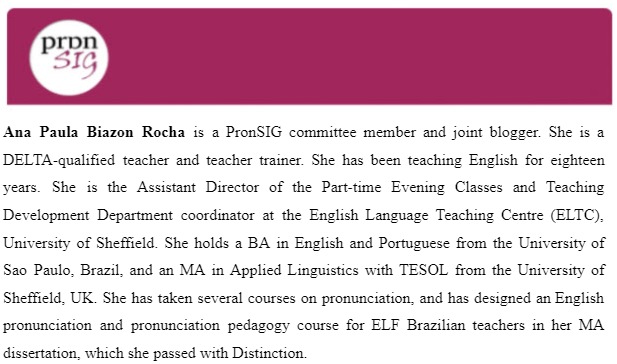By Ana Paula Biazon Rocha
In the September and October blog posts, we discussed the relevance and the challenges of pronunciation assessment in reference to PronSIG’s annual conference, Exploring effective pronunciation assessment practices in the English language classroom, on 01 Oct 2022. On the one hand, assessing learners’ pronunciation helps teachers identify the aspects that students should focus on and practise in order to improve their pronunciation according to their communicative goals. On the other hand, defining the more effective assessment tools and applying them in class are not that straightforward, and many teachers may feel a bit lost or unsure about it. That is why, in this post, we will start from the basics and analyse the first step to assess learners’ pronunciation: diagnostic testing.
1. What is Diagnostic Testing?
In language learning, when designing a course, it is of utmost importance to consider learners’ profiles, wants, lacks and needs (Nation & Macalister, 2011), which is known as Needs Analysis. This can be done through surveys, questionnaires, interviews, (in)formal chats, among others. As a complement, it is also pivotal to find ‘what learners can and can’t do with respect to a skill, task, or content area’ (Graves, 2000, p. 212), which is done through Diagnostic Testing. This does not necessarily mean that students have to do a test. A group task or an exercise in class, a homework assignment, an audio/video recording, a piece of writing, the teacher observing learners’ performance during the lesson, to name a few, can help teachers notice students’ weaknesses and strengths (Alderson, 2005; Nation & Macalister, 2011). Based on the Needs Analysis and the Diagnostic Testing, teachers can then make informed decisions about the lessons, the course plan, the syllabus design, assessment, etc., to better cater for learners’ needs and objectives.
Consequently, Diagnostic Testing tools should focus on the communicative skills that are being assessed (Anderson, 2005). Isbell and Sakai (2022) explain that if we are assessing pronunciation, we should concentrate on segmental (consonant and vowel sounds) and suprasegmental (stress, rhythm, intonation, linking) features (see a previous blog post for more details here).
2. What are examples of Pronunciation Diagnostic Testing?
A common example of diagnostic testing tool to assess pronunciation is to have learners record a paragraph such as:
Please call Stella. Ask her to bring these things with her from the store: Six spoons of fresh snow peas, five thick slabs of blue cheese, and maybe a snack for her brother Bob. We also need a small plastic snake and a big toy frog for the kids. She can scoop these things into three red bags, and we will go meet her Wednesday at the train station (Jones, 2019, p. 33).
Teachers can then analyse students’ pronunciation based on some features such as consonant and vowel sounds, consonant clusters, word stress, pausing/chunking, and/or linking sounds. As for the criteria, teachers can rank these features:

Grant and Yu (2017) provide another example of a paragraph that lower-level students can record, entitled “Why are you studying pronunciation?” (p. 04), and Grant (2017) also provides a paragraph that intermediate-onwards learners can record, entitled “Pronunciation Learning” (p. 02). Examples of a criteria form with pronunciation features are also presented by Grant and Yu (2017, p. 05) and Grant (2017, p. 05).
Alternatively, students can record the paragraph above, “Please call Stella”, and then compare their recording to other international speakers’ on the Speech Accent Archive website.
3. Is that all?
Nevertheless, as pointed out by Levis and Echelberger (2022) and Isbell and Sakai (2022), reading aloud as a Diagnostic Testing tool should be taken with a pinch of salt because: a) it is a prepared paragraph, not a sample of authentic speech; b) as such, it might add an element of pressure to learners because some might want to practise it many times before recording, which may not really represent their pronunciation weaknesses and strengths when communicating in English in real-life situations; in other words, a rehearsed speech sounds completely different from a natural, everyday one; c) it might not be enough to assess students’ pronunciation; and d) low-literacy learners may struggle with reading a paragraph aloud.
Thus, Levis and Echelberger (2022) suggest that students record themselves talking about a given topic, such as “My favourite holiday celebration” (p. 40), or that teachers record students’ speech while performing a task in class. The authors also highlight that when possible, learners should record a short video rather than an audio track, so that paralinguistic features of pronunciation, such as gestures, body movement and eye contact, can also be analysed. Finally, Levis and Echelberger (2022, p. 41) provide a useful assessment criteria grid to be used by teachers.
Another recommendation is to have learners look at a picture or some pictures and describe it/them to tell a story. In this way, they are authentically producing language and making use of a variety of pronunciation features. In Lane (2010), you can find an interesting series of pictures on page 255, and a broad assessment criteria form on page 256, which is quite practical and easy to use. Similarly, Miller (2007) presents two options of paragraphs that students can record and a series of pictures that students can describe/tell a story on pages 9 and 10.
Finally, the last thing to consider is the amount of pronunciation features and details teachers are going to focus on in the Diagnostic Testing. Clearly, it is not possible or even necessary to assess every little thing the student produces, so you should try and observe the main things that can inform you, the teacher, about your learner. Diagnostic Testing is supposed to support language learning, not to scare students away because of their pronunciation difficulties. Besides, there is only so much learners’ cognitive process can handle, so bombarding them with loads of pronunciation features and details is likely to be extremely overwhelming and demotivating. Balance and intelligibility are key!
Don’t forget to check our previous blog posts, follow PronSIG on social media and leave your comments below.
References
Alderson, J. C. (2005). Diagnosing Foreign Language Proficiency: The Interface between Learning and Assessment. London: Continuum.
Grant, L. (2017). Well Said. Pronunciation for Clear Communication. Fourth Edition. National Geographic Learning.
Grant, L. & Yu, E. E. (2017). Well Said Intro. Pronunciation for Clear Communication. Second Edition. National Geographic Learning.
Graves, K. (2000). Designing Language Courses: A Guide for Teachers. Boston: Heinle and Heinle.
Isbell, D. R., & Sakai, M. (2022). Pronunciation Assessment in Classroom Contexts. In J. Lewis, T. Derwing, T. & S. Sonsaat-Hegelheimer (eds.) Second Language Pronunciation. Bridging the Gap Between Research and Teaching. Hoboken and West Sussex: Wiley Blackwell. p. 194-214.
Lane, L. (2010). Tips for Teaching Pronunciation. A Practical Approach. New York: Pearson Longman.
Levis, J. & Echelberger, A. (2022). Integrating Pronunciation into Language Instruction. In J. Lewis, T. Derwing, T. & S. Sonsaat-Hegelheimer (eds.) Second Language Pronunciation. Bridging the Gap Between Research and Teaching. Hoboken and West Sussex: Wiley Blackwell. p. 19-41.
Miller, S. F. (2007). Targeting Pronunciation. Communicating Clearly in English. Second Edition. Heinle Cengage Learning.
Nation, J. & Macalister, I. S. P. (2010) Language Curriculum Design. First Edition. New York and London: Routledge.
Jones, T. (2019). 50 ways to teach pronunciation. Tips for ESL/EFL teachers. Wayzgoose Press.


